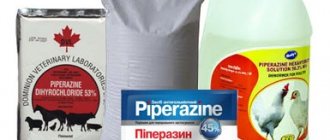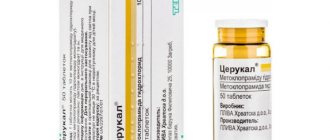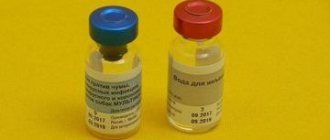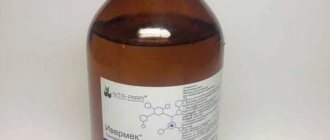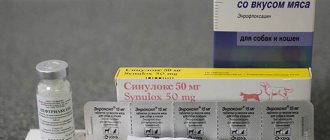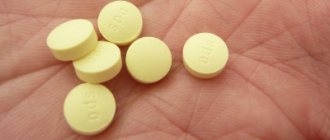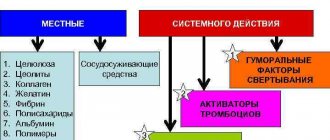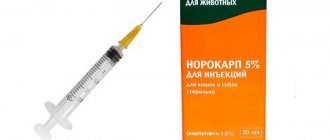Short description:
This drug is a synthetic analogue of vitamin K2. Unlike the natural vitamin, Vikasol is soluble in water. It is involved in many biochemical processes (intracellular respiration, phosphorylation, etc.). This drug increases blood clotting by stimulating the production of prothombin, proconvertin and other factors by liver cells that accelerate the formation of blood clots. These factors also take part in regenerative processes, helping to accelerate the wound healing process. The antihemorrhagic effect occurs 8-24 hours after administration of the drug. This depends on the form in which the medicine is used. Veterinarians usually prescribe Vikasol to animals together with other drugs to stop external or internal bleeding. It is indicated for hepatitis, cirrhosis of the liver, increased fragility of blood vessels, prolonged diarrhea, and in females - for uterine bleeding. This remedy is also sometimes prescribed for poisoning with certain types of anticoagulants (substances that reduce blood clotting).
For whom:
used to treat dogs, cats, horses, pigs, sheep, goats, rabbits and other mammals.
Leave form:
Available in the form of a solution for injection in ampoules of 1 or 2 ml. 10, 50 or 100 ampoules are packed in cardboard boxes. 1 ml of solution contains 10 mg of the active substance (menadione sodium bisulfite). This drug is also available in the form of tablets, each of which contains 15 mg of the active substance.
Dosage:
dogs, cats and rabbits are usually administered this vitamin intramuscularly at the rate of 1-2 mg of the drug per kg of animal weight per day. The veterinarian selects the amount of vitamin and the frequency of its administration individually, taking into account not only the weight of the animal, but also the extent of bleeding and the state of the blood coagulation system. The duration of treatment is most often 3-5 days.
Restrictions:
This drug should not be used if the animal has increased blood clotting, thromboembolism or allergies to the components of the drug. It is used with great caution for liver diseases and pregnancy. The simultaneous use of antibiotics reduces the absorption of Vikasol by the body. Intramuscular administration of this medication is usually painful for the animal. There may be pain and swelling at the injection site. To stop significant bleeding, only the administration of this vitamin is usually not enough; in this case, complex treatment is necessary.
Reviews about “Vikasol (tablets, ampoules for injection) for dogs and cats”:
Young rabbits raised in a common cage announce puberty with banal fights. Young males begin to chew and chase away potential competitors. The only way out is castration if resettlement is pointless. For example, a slaughter is planned.
The castration procedure is as follows: - males who show excessive zeal are resettled immediately; - on the eve of the operation, a neighbor is invited who is graduating from the veterinary department of the college; — the future specialist brings tablets “Vikasol”, which will increase blood clotting after 12 hours; - carrots are peeled, cut and stuffed with doses of crushed preparation; — medicinal carrots are fed to males; — in the morning, a neighbor is performing an operation.
The logical question is: why do we avoid the Vikasol vaccine? The answer is simple: fuss with disposable syringes, breaking off the end parts of ampoules, disinfecting injection sites and other manipulations is inappropriate.
"Vikasol" solves the main problem, the rapid healing of incisions over the ovaries, the healing of remaining tissue.
Pharmacokinetics
When injected into the muscle of an animal, the effect of the drug will begin within 5-15 minutes. The most powerful effect will appear after 1.5-2 hours. When taken orally, this will take 3-4 hours. With one-time use, the effect of the substance completely stops after 24 hours.
Etamsylate is well absorbed and distributed evenly in the body. However, it does not bind to proteins and formed elements of the blood. Having launched the necessary processes, Etamzilat is quickly and almost unchanged eliminated from the body by the kidneys. After 4-5 hours, not even a trace will remain of it.
Etamsylate combines extremely poorly with other drugs. When mixed in the same syringe with other medications, it may lose its properties or have a negative effect on the animal’s body. During treatment with Etamsylate, it is better to completely abandon other methods of pharmacological support.
After intramuscular administration, it is easily and quickly absorbed. The effect begins within 8-24 hours. Accumulates in tissues in small quantities. After going through a cycle of metabolic activation, it is oxidized to the diol form. They are excreted by the kidneys (up to 70%) and with bile exclusively in the form of metabolites. High concentrations of vitamin K in feces are due to its synthesis by intestinal microflora.
Indications
- bleeding after wounds, trauma and surgery;
- hemorrhagic syndrome associated with hypoprothrombinemia;
- overdose of vitamin K antagonist drugs (neodicoumarin, phenylin, etc.);
- hypovitaminosis K (with obstructive jaundice, hepatitis, liver cirrhosis, prolonged diarrhea).
Check with your veterinarian for the method of use of Vikasol, dosage, and duration of treatment.
Drug interactions Vikasol: reduces or blocks the anticoagulant effect of neodicoumarin and phenylin. Does not affect the anticoagulant activity of heparin. Simultaneous administration with broad-spectrum antibiotics, quinidine, quinine, salicylates in high doses, antibacterial sulfonamides requires an increase in the dose of vitamin K.
Storage conditions for Vikasol: in a place protected from light, at a temperature of 2–8 °C. Keep out of the reach of children. Shelf life: 2 years.
general characteristics
Vikasol is a coagulant that has long been successfully used to treat the liver and improve blood clotting in humans. It is no less actively used in veterinary medicine. This is an artificial substitute for vitamin K, an insufficient amount of which reduces blood clotting, so the slightest wound in an animal can lead to extensive blood loss.
The active ingredient of the drug is menadione sodium bisulfite. Vikasol is an analogue of vitamin K, obtained by chemical synthesis.
The drug is available in two dosage forms - tablets for oral use and solution for injection. The content of the active substance in the medicine depends on the dosage form:
- in tablets – 15 mg;
- in solution for injection – 10 mg/1 ml.
Content
1. General characteristics 2. Effect of the drug 3. Application of Vikasol 4. Purpose and dosage 5. Contraindications and side effects 6. Price 7. Reviews from dog owners and specialists
With various types of injuries that cause bleeding, the dog’s body tries to independently restore the integrity of the blood vessels, while forming clots in the blood. If there is a bleeding disorder, even the slightest wounds cause extensive bleeding, which can lead to the death of the pet. Vikasol for dogs is a remedy that can restore blood clotting, which depends on vitamin K.
Application of Vikasol
Vitamin K deficiency can cause the slightest injury to cause bleeding that is difficult to stop. In addition, lack of vitamin:
- increases capillary fragility, which increases bleeding even with the slightest bruises or injuries;
- disrupts biological processes in the body, primarily in the liver.
In severe cases, this will lead to the death of the animal. A lack of vitamin K is especially dangerous when a dog is poisoned, so Vikasol is considered an effective antidote in cases of animal poisoning with rat poison.
Once in a dog’s body, Vikasol activates the liver to produce a special substance that improves blood clotting. Due to the pronounced hemostatic properties of the drug, it is prescribed in the following cases:
- for capillary and internal bleeding;
- stomach ulcer in case of bleeding;
- with hepatitis and cirrhosis of the liver, other diseases of this organ;
- with uterine bleeding in females.
Similar article - Papillomas, what is it and how to get rid of it
The coagulant is used after surgical interventions and injuries that led to the presence of open wounds and damage to internal organs. It improves tissue regeneration, promoting faster wound healing.
In case of poisoning with rat poison - coumarin - Vikasol is used as an antidote, but since its effectiveness appears only 7-12 hours after administration, it is necessary to combine the medication with other first aid methods:
- gastric lavage;
- taking other fast-acting drugs, for example Konakion.
Vikasol retains its therapeutic effect for 18 hours after administration.
How does it work and how is it used?
Vitamin K helps the liver release substances that increase blood clotting. A lack of this vitamin in the body leads to the following consequences:
- bleeding increases and blood clotting decreases;
- increased capillary fragility;
- biological processes occurring in the liver are disrupted.
Vikasol is used for dogs for the following pathologies:
- with capillary bleeding;
- for internal bleeding caused by various factors;
- with bleeding in the stomach caused by peptic ulcer;
- with hepatitis;
- with cirrhosis of the liver;
- for other severe liver diseases.
The drug can also be used for females with uterine bleeding. The medicine can be used for injuries accompanied by severe bleeding, and after surgical interventions. In this case, the coagulant stops or prevents bleeding and speeds up the wound healing process.
Vikasol is also prescribed to dogs for vitamin K deficiency in the body. This may be indicated by fragility of blood vessels, prolonged diarrhea and other symptoms. Before starting to use the medicine in this case, a comprehensive medical examination and consultation with a doctor is required.
Important! Vikasol is often used as an antidote for poisoning with zoocoumarin or rat poison. Since the medicine does not act immediately, it is combined with gastric lavage and treatment with other medications.
The medicine begins to act only 7-12 hours after administration, and the therapeutic effect lasts for 18 hours.
Purpose and dosage
Only a doctor should prescribe any medications. Since Vikasol has a number of contraindications, its independent use for veterinary purposes is prohibited.
The medicine is produced in two forms - in the form of tablets and a solution, which is administered intramuscularly. The injections are quite painful, but they begin to act much faster than tablets, so they should be preferred in case of poisoning or vomiting in a dog. Before injecting, you need to warm the ampoule in your hand.
Tablets are given with food or forcibly - by placing the medicine on the root of the tongue and waiting for the pet to swallow it. You can use a tablet dispenser.
The dosage will be determined by your veterinarian and is calculated based on several factors:
- animal weight;
- type of pathology (coumarin poisoning, liver disease or bleeding caused by any reason);
- symptoms of the disease and the general condition of the dog.
The usual course of treatment is 3-5 days; the need for further treatment or discontinuation of the drug is determined by the veterinarian.
Directions for use and doses
It is best for cat owners to use tablets, since their simple use does not require any veterinary or medical skills. Each pill contains 15 mg of active ingredient. Per kilogram of live weight requires 1-2 mg. Simply put, the average cat needs about ¼ of a tablet. The frequency of use and duration of treatment must be determined by a veterinarian. As a rule, the duration of therapy is from 3 to 5 days.
One milliliter of solution contains 10 mg of active substance. The drug is oily, and therefore before use it should be heated to a temperature of approximately 37 degrees. The medicine is administered intramuscularly. When using antibiotics simultaneously, it should be taken into account that the efficiency of drug absorption is reduced. Perhaps the dosage should be increased slightly, but consultation with a veterinarian is necessary.
Bleeding is a pathology known to people since ancient times. Man has long learned to help himself and animals if such trouble arises. An effective remedy to help fight bleeding is Vikasol for cats.
Contraindications and side effects
Taking Vikasol for self-medication is prohibited, since the drug has a number of contraindications:
- individual intolerance to the drug;
- increased blood clotting;
- thromboembolism;
- liver dysfunction.
During pregnancy, the drug is prescribed to females only after a veterinarian has assessed the risk for the animal and its offspring. If it is necessary to take antibacterial drugs simultaneously, the dose must be adjusted, since antibiotics suppress the effect of Vikasol.
Side effects may occur if you are intolerant to the components of the drug. In this case, the following are possible:
- rash and redness on the skin;
- itching;
- bronchospasm.
Complications after taking Vikasol rarely occur; swelling may appear at the injection site, but it will go away quickly.
The medicine is sold in a regular pharmacy, the price, depending on the region, is 17-20 rubles for 20 tablets. The solution for injection is a prescription drug, the price of 10 ampoules is 50-70 rubles.
Description of the drug
"Etamzilat" is a hemostatic drug. The action of Etamzilat is based on enhancing hemostat. The hemostatic effect is based on stimulating the formation of thromboplastin at the site of injury. At the same time, the drug does not increase the number of platelets in the blood plasma, due to which it does not provoke the appearance of blood clots.
"Etamzilat" tablets
With the help of Etamzilate, the synthesis of mucopolysaccharides in capillary tissues is enhanced. This helps strengthen blood vessels, improves their resistance to mechanical stress and the circulation of nutrients. Due to the properties inherent in the product, the volume and duration of bleeding is significantly reduced. This often plays a decisive role in cases of serious injuries accompanied by large blood loss.
Etamsylate in ampoules of Ukrainian production
Etamsylate is used both for therapy in animals and in helping people.
You can purchase the product in tablets and in liquid form for intramuscular administration. In addition to the name “Etamzilat”, used internationally, the drug is known in the CIS countries as “Ditsinon”. Both products have identical composition and effects.
Tablets "Ditsinon" (Etamsylate)
"Ditsinon" tablets
Dicinon tablets have a slightly grayish or snow-white color. The shape of the pill is round, biconvex. The tablets are packed in a blister. The box may contain 5 or 10 blisters of 10 tablets each.
Appearance of the Dacinone tablet
There are 2 types of drug dosage:
- tablets of 0.25 g - for the treatment of adults and animals;
- tablets of 0.05 g - used for pediatric patients.
The substance that provides the main effect is ethamsylate. Other components included in the tablets:
- povidone;
- lactose monohydrate;
- corn starch;
- anhydrous citric acid;
- Magnesium stearate.
Liquid injection
Liquid for injections is available in colorless ampoules with a capacity of 2 or 1 ml. They contain a completely clear or slightly colored sterile composition designed for intravenous and intramuscular use. The product is produced in cardboard boxes of 10, 20 or 50 ampoules.
"Ditsinon" in ampoules
1 ml of solution contains:
- etamsylate - 125 mg;
- sodium disulfite - 4.0 mg;
- edetate disodium - 0.1 mg;
- purified water for injection - up to 1 ml.
Reviews from dog owners and specialists
Vikasol is always in my medicine cabinet. Recently, the owners of a dog with uterine adenocarcinoma contacted me. I had to operate, everything was successful, but internal bleeding began. Prescribed Vikasol intramuscularly. We recently brought our dog in for a medical examination - she is doing well.
Irina Fedotova, owner of a Western European Shepherd
My Dorothy was diagnosed with liver toxicity. Comprehensive treatment was prescribed, including Vikasol. I injected myself, I am a nurse by profession. Already on the third day, the yellowness of the skin decreased, the dog became more active, ate and drank, and quickly began to recover.
Alena, owner of a dachshund
My baby had her first birth and started bleeding. I called the veterinarian to the house, he prescribed a course of Vikasol. The bleeding was quickly stopped, and then we took tests that showed that blood clotting had improved.
Tatyana, veterinarian at a private veterinary clinic
I use Vikasol in my work when I have to deal with wounds and surgical operations - it improves blood clotting and promotes rapid tissue healing. The drug is also prescribed for poisoning and liver diseases - dogs recover faster if owners seek help in time.
What is Vikasol for dogs? During the autumn-spring periods, there is an acute lack of vitamins, and the dog feels it no less (if not more) than you. It is important to remember that the dog, like you, needs various macro- and microelements.
Dog owners pay attention to walking, feeding and training. But do not forget that monitoring the general condition of the dog’s body is the same necessary precaution and care, which means you need to visit the veterinarian not only when there are acute reasons, but also for preventive examinations.
The drug "Vikasol" is a fat-soluble form of vitamin K, which is available in ampoules and tablets. This vitamin, necessary for the normal functioning of the pet’s body, is also called phylloquinone.
The main function of the vitamin is to normalize metabolic processes and blood clotting. The presence of this substance in the animal’s body has a significant effect on protein synthesis and the formation of bone and cartilage tissue.
Reviews from veterinarians
Olga, veterinarian with 13 years of experience:
“An excellent, albeit cheap product. For bleeding in animals - first and indispensable aid. Vikasol helped me save several animals from rat poisoning, but in this case you shouldn’t self-medicate. It’s better to seek help from a specialist, as delay can cost the animal its life.”
Nikolay, veterinarian with 8 years of experience:
“I specialize more in performing operations on animals, so I often use this drug in my practice. For example, just recently it was necessary to urgently operate on a dachshund with a tumor on the uterus. The entire organ had to be removed to save the life of the 3-year-old beauty. The operation was successful, but after a while internal bleeding began. Vikasol injections helped prevent fatal consequences. This is one of the cases from my practice, and there are many of them. The only disadvantage of the drug is the pain of the injections. I didn’t notice any other side effects.”
1. https://zoomir.mybb.ru/viewtopic.php?id=130 2. ATTENTION - ISONIAZID poisoning! — https://wap.reddogfoto.forum24.ru/?1-11-0-00000109-000-0-0 A). “...Symptoms: The dog begins to lose coordination, its legs give way, it skids to the sides. Vomiting Excessive salivation Convulsions Symptoms depend on the degree of poisoning. What to do: Inject the dog intramuscularly with vitamin B6 (10 cc per 10 kg of dog weight) Induce vomiting (give sunflower/olive oil or salt water) Go to the doctor immediately. The effect of the poisonous drug: begins to act approximately 2-3 hours after entering the body, paralysis of the respiratory muscles occurs, treatment is accompanied by the release of foam from the mouth, howling is possible... Eternal calm occurs on average after 4-5 hours, in some cases a longer period is possible . There is an antidote that allows you to neutralize the effect of the drug. This is vitamin B-6. It is administered intravenously up to 10 cc. see per 10 kg of weight, depending on the degree of poisoning. This drug is not poisonous and is sold freely, but in a certain dose it is fatal for dogs. There is a specific antidote for this drug: the readily available drug PYRIDOXINE, also known as vitamin B6. If poisoning is suspected, it can and should be used preventively, i.e. before consulting a veterinarian (time is precious). This vitamin is non-toxic even in large doses, so even if another poison is later confirmed, it will not be worse. If there is any suspicion of poisoning, first of all forcefully 0.5 cups of vegetable oil. Then Corvalol, depending on the size of the animal. Pyridoxine hydrochloride, depending on the size of the animal, I have huskies, I administer 2 ampoules to them at once. After all this, milk diluted in half with water is unlimited. Milk can be replaced with any liquid in combination with diuretics. The algorithm is as follows: 1. Induce vomiting (for example, by giving a saline solution - a tablespoon per glass of water, oil (but there was a reservation for the liver) 2. After vomiting, adsorbents. 3. Cleansing enema + laxative salts 4. Give as much liquid as possible + diuretics, antispasmodics are possible. 5. To the veterinarian... - we start, as usual, with ABC and venous access - five grams of pyridoxine intravenously is enough to stop poisoning in most cases - convulsions are stopped with diazepam intravenously - put a tube in the stomach and wash out the rest, give charcoal or polyphepan dosages require clarification from veterinarians. “When using ... and other derivatives of isonicotinic acid, it is advisable to prescribe pyridoxine 0.005-0.01 g per day prophylactically - to prevent neuritis (inflammation of the nerve) and other complications.” And this is to prevent complications, NOT MORE: In case of poisoning, and this can be noted after a certain time, unfortunately (the dog itself will not say what it ate), at least 500 mg (10 ampoules of 5% -1.0) must be administered intravenously, without a guarantee of results. A few more clarifications: They poison with isoniazid. This is an anti-tuberculosis drug, extremely toxic in large doses. Domestic dogs, having grabbed a piece of sausage with poison, die within half an hour... “B). “...Isoniazid poisoning Clinical picture. The first signs of poisoning - nausea, vomiting, dizziness, dysarthria, drowsiness, confusion - appear 30-60 minutes after ingestion of more than 20 mg/kg of isoniazid. In case of severe poisoning, respiratory depression, convulsions, lactic acidosis, and coma are possible. Convulsions are usually long-lasting and cannot be stopped with anticonvulsants... Immediately inject 10 cubic meters of vitamin B6 intramuscularly!!! (this really helps) TREATMENT. Urgent measures are taken to remove the toxic substance from the gastrointestinal tract and symptomatic therapy. Isoniazid is well adsorbed by activated carbon. Seizures can sometimes be controlled with benzodiazepines and barbiturates, but usually they only go away with the administration of pyridoxine (vitamin B6). Diazepam and pyridoxine act synergistically. Pyridoxine is administered intravenously in a dose equal to the amount of isoniazid taken. If this amount is unknown, then 5 g of pyridoxine is prescribed. For patients with convulsions it is administered within 5 minutes, without convulsions - within 30 minutes. Administration of pyridoxine can lead to rapid cessation of seizures and correction of metabolic acidosis, but consciousness is sometimes restored only after several hours. For acidosis, sodium bicarbonate may be needed. If the effect is incomplete or symptoms recur, the administration of pyridoxine is repeated. When the first clinical signs appear IMMEDIATELY - give activated carbon 1-3 g. per 1 kg of weight - 0.5 cups of vegetable oil forcibly. Then Corvalol (30 drops per 40 kg.) Pyridoxine hydrochloride - After all this, milk diluted in half with water is unlimited. Milk can be replaced with any liquid in combination with diuretics and the algorithm is as follows: 1. Induce vomiting (for example, by giving a saline solution - a tablespoon per glass of water, oil (but there was a reservation about the liver) 2. After vomiting, adsorbents (activated carbon, enterosgel ). 6-12 hours, 10 ml of a 5% solution. Diazepam and pyridoxine act synergistically. Intravenous drip use of a 4% solution of sodium bicarbonate is indicated - up to 1000 ml. Helps eliminate acidosis. Administration of pyridoxine can lead to a rapid cessation of seizures and correction of metabolic acidosis, but consciousness is sometimes restored only after a few hours 5. To the veterinarian Poisoning with rat poison First aid for poisoning with rat poison Briefly what everyone should know from the book “100 canine “whys””, V. Gritsenko, V. Pilyugin: Usually from the moment a dog comes into contact with rat poison (most likely it is zoocoumarin) until the first signs of poisoning appear, 1 to 10 days pass. Zookoumarin = rat poison - bloody vomiting, bloody diarrhea. Dogs should not be fed under any circumstances; feeding may accelerate the absorption of the poison. Before contacting a veterinarian, you should try to cleanse the stomach by drinking plenty of boiled water with adsorbents (activated carbon, polypefam, enterosorb), thereby inducing vomiting, then give a glass of laxative salt solution (magnesium sulfate or sodium sulfate - a tablespoon per glass of water). Give your dog milk, water, and strong iced tea. Contact your veterinarian as soon as possible. Antidote - vikasol (vitamin K1) This is what rat poisons are and how they work. Most rodenticides are anticoagulants (i.e., they interfere with blood clotting). Clinical symptoms appear on days 3-4. Basically this is excessive salivation, vomiting, often with blood clots, shortness of breath, weakness, etc. Further treatment depends on the stage. Within a few hours, it is necessary to give an adsorbent, preferably some strong enterosgel, for example, if this is not available, then activated carbon is enough (but you will have to stuff the package in one go), emetics, then, depending on the poison, an injection of VIKASOL is given, this is a synthetic analogue of vitamin K, the natural vitamin is absorbed in the intestine in the presence of fat and bile, and for the resorption of vikasol, bile and fat are not needed, because it is soluble in water. It is a coenzyme of the enzyme responsible for the synthesis of blood clotting factors and prothrombin synthesis in the liver. NOT FOR INTRAVENOUS ADMINISTRATION. In our clinics, it is Vikasol that is used, although it cannot completely replenish vitamin K, the survival rate is 80%. In later stages, blood transfusion (blood transfusion) is used. If an animal is poisoned by a poison that contains, in addition to zoocoumarin, arsenic poisons, UNITOL is used. Unithiol is used to treat acute and chronic poisoning with compounds of arsenic, mercury, chromium, bismuth and other metals related to the so-called thiol poisons, i.e. substances that can interact with sulfhydryl (thiol) groups of enzyme proteins and inactivate them. They react with thiol poisons found in the blood and tissues and form non-toxic complexes with them, which are excreted in the urine. The binding of poisons leads to restoration of the function of the body's enzyme systems affected by the poison. With a large dose of rat poison containing zoocoumarin - Vikasol, Vitamin K1, this is a very slow help, it is necessary to do a blood transfusion. We need to take him to a veterinary clinic for clotting factor testing. If everything is at an acute stage, then it is better to do a transfusion without hesitation. If the dose was small, the indicators of the factors are not greatly impaired, you can use Vitamin K3 (Vikasol) or Vitamin K1 of your choice. Also, the drug “Konakion” is very effective against rat poison...” B). “Isoniazid • Symptoms The first signs of poisoning occur after 30-60 minutes. after administration - nausea, increased salivation (foam), drowsiness, disorientation. After 1-3 hours, respiratory depression, arrhythmia, convulsions, and coma are observed. Antidote: PYRIDOXINE HYDROCHLORIDE (vitamin B6) First of all, immediately administer Pyridoxine (vitamin B6)! Intramuscularly, for small dogs, up to approximately 20 kg, about 4-5 ml. More than 20 kg approximately 6-7 ml. There is no need to worry about overdosing, it is a vitamin and it is quite difficult to overdose on it. Remember that administering lower dosages may be fatal. Isoniazid is well adsorbed by activated carbon. After the convulsions have stopped, we inject into the mouth with a 20 ml syringe (without a needle) a suspension of crushed activated carbon in water. Next, we urgently transport the dog to the clinic, because... IVs are needed. Tell your doctor the dosage of the toxic substance, which is usually equal to 3 g. Antifreeze (ethylene glycol) • Symptoms Frequent vomiting, depression, loss of coordination, lethargy leading to coma. The latent period from the moment of eating until the appearance of clinical signs can last from several minutes to 4 hours. Antidote: ETHYL (wine) ALCOHOL It is necessary to induce vomiting (open the dog’s mouth, pour half a teaspoon of dry table salt onto the root of the tongue, do not lift the animal’s head. Severe irritation of the taste buds of the tongue will cause vomiting). Then inject ethyl (wine) alcohol into the mouth at a dose of 0.5-1 mg/kg. It must first be diluted to 40% (vodka), that is, 0.9-1.5 ml of vodka per 1 kg of weight. Contact the clinic immediately. • Rat poison (zoocoumarin) Symptoms The first symptoms may appear at the earliest 2-3 days after poisoning, but, as a rule, occur on the 5-7th day. These are bleeding from the nose, gums, gastrointestinal tract, kidneys, hemorrhages and the formation of hematomas. Animals become increasingly weak. Vomiting of blood, shortness of breath and cough, redness of the mucous membranes may occur. Antidote: VITAMIN K1 1) inject dicinone (etamsylate) intramuscularly – 1 amp. 2) inject Vikasol subcutaneously - 3 ml 3) inject 100-200 ml of Aminocaproic acid solution into the mouth with a syringe (without a needle). Contact a veterinary clinic immediately! • Strychnine• Symptoms The onset of the disease is sudden (less than two hours). Excitement, irritability, a feeling of fear, which are quickly followed by intense painful “tetanus” convulsions, lasting about 60 seconds, during which the dog throws its head back, cannot breathe and turns blue. Even mild stimuli, such as tapping or flapping your hands, cause cramps. This characteristic reaction helps to quickly establish a diagnosis. Other signs of damage to the nervous system include: tremors, “chomping”, drooling, twitching of individual muscles, collapse and wide stance of the limbs. Antidote: no If there are signs of poisoning on the face, but the dog is alert, can swallow on its own and is not vomiting, it is necessary to induce vomiting (open the dog’s mouth, pour half a teaspoon of dry table salt on the root of the tongue, do not lift the animal’s head), rinse the stomach (0.5% potassium permanganate solution or just water). After lavage is completed, introduce activated charcoal into the stomach and consult a doctor. ..." 3. Antidote or antidote - https://ru.wikipedia.org/wiki/Antidote 4. WHAT TO DO IF A DOG HAS BEEN POISONED. — https://zoomir.forumbb.ru/viewtopic.php?id=188 5. First aid for Poisoning. — https://sadistam.net/?q=node/5 6. 7.
What is Vikasol needed for?
Thanks to the rapid development of veterinary medicine, we know that the importance and benefits of Vikasol (K2) are due to the fact that it is responsible for the normal synthesis of proteins that enter the body, as well as for the full metabolism necessary to maintain life. Vitamin K ensures metabolism at the cellular level and acts as a catalyst in the synthesis of certain liver proteins, which are necessary for good blood clotting and to ensure there is no risk of thrombosis.
Sources of vitamin
Fish meal and bone meal are average sources of vitamin K2, but they may not be present in your dog's diet in the full amount needed for adequate production of the vitamin. What to do you ask? Science has made great strides forward and has learned to produce synthetic substances that become, if not substitutes, then definitely good analogues of natural vitamins. Such components mainly contain vitamin K3. The latter is transformed in the dog’s body into vitamin K2 in its active form.
Similar article - What can a pelvic ultrasound show?
What if there is a shortage?
What can a lack of this vitamin lead to in a dog’s body? In case of a deficiency of menaquinone (that is, vitamin K2), there is a risk that even with small and minor external or internal injuries, major bleeding (hemorrhages) is possible in different organs and tissues of the body.
The latter, according to medical statistics, causes death for the animal. You should be careful with treatment with antibacterial drugs (antibiotics), since the destruction of intestinal microflora is directly related to the amount of vitamin K in the body.
Application
Vikasol is used to prevent internal bleeding after surgery, in case of poisoning with toxins, various forms of hepatitis, jaundice, or the presence of other injuries. By the way, many owners call Vikasol for dogs in case of poisoning one of the best solutions. The drug reaches its maximum effectiveness only 15 hours after use.
Application is possible in the form of a white free-flowing powder, which dissolves well in water, but has a bitter taste. The drug is commercially available in the form of ampoules with a capacity of 1-2 ml for injection. The solution is a 1% liquid, containing 1 mg of menadione sodium bisulfite per 1 ml of volume.
The instructions for Vikasol for dogs state that the dosage of Vikasol in this case for dogs is 0.01-0.03 g/kg. In addition to these forms, there are also Vikasol tablets (usually 25 pieces or 50 pieces per package). Each of them contains 15 mg of the active component mentioned above.
How to use?
If an injection solution is used for treatment, it is administered intramuscularly. Due to the pain of injections, tablets are often preferred, but in case of vomiting or poisoning, injections should be used. To reduce pain, the ampoule with the medicine must be warmed in your hands before drawing the contents into the syringe.
Tablets are given to the dog forcibly or along with food. The method should be selected taking into account the characteristics of the animal. Some pets sense drugs in food and therefore refuse it. If you can’t give the pills by trickery, then forcefully put them on the root of the tongue. It is better to use a special device for these purposes, especially if you have a large or aggressive dog.
In the instructions for use of Vikasol you will not find dosages for dogs, since it is formulated for humans. On average, a single dosage is used - 1-2 mg of the active substance per 1 kg of animal weight, but the veterinarian must determine the exact dose. When calculating the dose, the doctor must take into account a number of factors:
- type of pathology (poisoning, liver disease, bleeding);
- symptoms;
- general health;
- age and weight of the animal;
- other variables that may have an influence.
Animals should not use the drug for self-medication. In case of bleeding, the use of a coagulant alone may not be enough. Other medications may be needed. The duration of treatment is also determined by the veterinarian, but usually the medicine is taken for 3-5 days.
Important! In case of poisoning, Vikasol must be combined with other drugs. Do not wait for the medication to work; contact the clinic for medical help if your animal has symptoms of poisoning.
Signs of phylloquinone deficiency in the body
Below is a list of problems for which the Vikasol injection is considered mandatory.
- joint diseases;
- severe wasting with a progressive tendency;
- problems with blood clotting - if even a very small wound or cut bleeds for a long time;
- diseases of the genitourinary system;
- severe anemia;
- blood poisoning by parasites;
- liver disease, especially if it is chronic;
- cholecystitis.
Urgent injections are required in case of acute poisoning or if a biochemical analysis of the animal’s blood shows a minimal amount of phylloquinone and prothrombin.
How to use the drug
In pharmacies, Vikasol is sold in the form of tablets and oil solution. 1 ml of solution contains up to 10 mg of active substance. 1 tablet contains 15 mg. The tablets are given to the animal along with food, and the solution is administered intramuscularly. During injection, the drug should not be cold. It is slightly heated.
How to calculate the required dose? For every kilogram of your pet's weight, you need to take 1-2 mg of Vikasol.
Symptoms of vitamin K deficiency and indications for use
They are quite severe, but develop gradually. So there is enough time to notice clinical manifestations:
- Blood biochemistry may reveal a lack of prothrombin. This is the most important protein involved in the coagulation process. If the amount of protein decreases to 15-20% of the normal level, the cat may die at any time from massive internal bleeding.
- Due to the important role of vitamin K in metabolism, when it is deficient or poorly absorbed, progressive depletion occurs.
- Persistent liver diseases, especially cholelithiasis and chronic cholecystitis, can also prompt an experienced diagnostician to think about problems with phylloquinone.
It should be taken into account that with long-term use of antibiotics and drugs from the sulfonamide group, problems with prothrombin synthesis are also observed, caused, among other things, by the destruction of vitamin K.
So, when should you give your cat Vikasol? Firstly, it will definitely not interfere with animals recovering from severe injuries, especially wounds, as well as those in the recovery period after infectious diseases. Vikasol is especially indicated for those cats who have suffered from some kind of blood-parasitic infection!
Secondly, it is extremely necessary for poisoning with almost all types of rat poisons, since they cause severe internal bleeding, blocking the blood clotting function. Indirectly, this drug is necessary for urolithiasis (that is, urolithiasis). Of course, phylloquinone itself will not dissolve stones, but it will significantly reduce the risk of death or anemia from constant blood loss resulting from injury to the urinary system.
Important! There are cases where cats have been diagnosed with a lack of vitamin K... due to the abuse of garlic sausage! In case you like to “pamper” your pet, remember that this product (as well as garlic, of course) contains substances that destroy phylloquinone.
Considering all of the above, vitamin K is essential for cats undergoing antibiotic therapy for any disease. Of course, when using sulfonamides, Vikasol for animals will also not be superfluous.
Side effects or harm of Vikasol
As a consequence of the fact that Vikasol can be administered intramuscularly to a dog, pain is caused in the dog. Swelling may occur at the injection site. The harm and benefits of Vikasol for dogs are assessed individually by a veterinarian. Self-medication is unacceptable here.
A lack of phylloquinone has a negative impact on the health of dogs, especially large breeds. Why is so little known about this drug and why is it not included in animal nutritional supplements?
Vitamin K is found in sufficient quantities in animal and plant foods. If the pet's diet is well balanced and the dog receives the entire list of products, there is no need to add phylloquinone.
Reviews
We will present only drugs that have been tested by veterinarians, and most importantly, time-tested. To prove this, consider a few reviews:
“We faced a problem like an ulcer. Our Nancy spends a lot of time with her son, so as soon as he noticed strange behavior, he was immediately taken to the veterinarian for an examination. In the conclusion of the latter, he clearly indicated - an ulcer. During the examination, it turned out that there was already internal bleeding, which means it must be treated immediately. They prescribed Vikasol and did an excellent job. But it is important to consider that such an effect is achieved only during complex treatment, and not with one drug.”
“I was shocked when, upon returning from work, I found Phil vomiting blood. It became clear that the rumors that they started poisoning dogs in the yard were not rumors at all. I immediately realized that the matter was connected with poison. The dog is in the car and to the vet. Vikasol was prescribed as an antidote. It was done quickly and everything worked out well.”
“I gave my sister a puppy for her birthday, she always dreamed of him. Naturally, a trip to the veterinarian was the first thing done. They explained to us that this vitamin plays an important role in the formation of bone tissue and its subsequent mineralization, so they prescribed Vikasol as a preventive measure while the musculoskeletal system is still forming. Jersey is growing, there are no problems with taking pills at all. I recommend it, but be sure to discuss this with your veterinarian!”
And these are just a few of the thousands of positive reviews from real people who once faced real problems with their pets. However, you should not self-medicate your dog. The key to recovery is timely consultation with a competent specialist, detection of the problem at an early stage and, of course, comprehensive treatment, proper nutrition and adherence to the regime.
Treatment of enteritis
There is no single ideal cure for enteritis. Symptomatic treatment is carried out in parallel with the administration of vitamins, as well as medications to support the heart and liver. Full recovery of a dog after clinical recovery takes a decent amount of time. If enteritis is suspected in dogs, treatment at home is pointless and risky!
Differentiation by type of enteritis is not carried out due to the duration of laboratory analysis and the rapidity of development of the disease. In any of the cases, treatment is carried out as for parvovirus enteritis, observing the dynamics of the animal’s condition, changes in the clinic and making adjustments to medications as therapy progresses.
Important: enteritis of viral origin should only be treated by a veterinarian under his strict supervision! There are no folk or home methods to combat these diseases, even taking into account the ease of some mild forms!
Treatment is carried out according to the following algorithm:
- destruction of enteric viruses;
- removing the animal from dehydration;
- elimination of vomiting and diarrhea;
- detoxification therapy;
- stimulation of immunity;
- restoration of normal functioning of the gastrointestinal system;
- restoration of normal functioning of the cardiovascular system.
Important: all medications at the beginning of therapy are administered only by intravenous, subcutaneous and intramuscular injections. Frequent vomiting and disturbances in the functioning of the intestines and stomach exclude the possibility of taking drugs orally (through the mouth).
The main goal of treatment is to most effectively support the functioning of all organs and systems of the body until the animal’s own immune forces begin to fight the disease (by 5-6 days, when the production of its own antibodies to fight viruses begins). Considering the rapid dynamics of the development of the disease, literally within a day from the start of treatment, the animal will either feel better (which will be a start to recovery), or the animal will die (if the treatment did not bring effective results). But it always makes sense to fight for the life of a pet!
